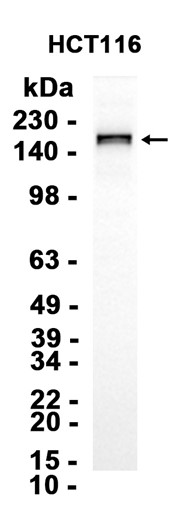DEPDC5 (3L15) Rabbit Monoclonal Antibody
DEPDC5 (3L15) Rabbit Monoclonal Antibody
- 产品详情
- 实验流程
- 背景知识
Application
| WB |
|---|---|
| Primary Accession | O75140, P61460 |
| Reactivity | Human, Mouse |
| Clonality | Monoclonal |
| Calculated MW | 181264 Da |
| Gene ID | 9681 |
|---|---|
| Dilution | WB~~1:1000 |
| Storage Conditions | -20℃ |
| Name | DEPDC5 {ECO:0000303|PubMed:23542697, ECO:0000312|HGNC:HGNC:18423} |
|---|---|
| Function | As a component of the GATOR1 complex functions as an inhibitor of the amino acid-sensing branch of the mTORC1 pathway (PubMed:23723238, PubMed:25457612, PubMed:29590090, PubMed:29769719, PubMed:31548394, PubMed:35338845). In response to amino acid depletion, the GATOR1 complex has GTPase activating protein (GAP) activity and strongly increases GTP hydrolysis by RagA/RRAGA (or RagB/RRAGB) within heterodimeric Rag complexes, thereby turning them into their inactive GDP-bound form, releasing mTORC1 from lysosomal surface and inhibiting mTORC1 signaling (PubMed:23723238, PubMed:25457612, PubMed:29590090, PubMed:29769719, PubMed:35338845). In the presence of abundant amino acids, the GATOR1 complex is negatively regulated by GATOR2, the other GATOR subcomplex, in this amino acid-sensing branch of the TORC1 pathway (PubMed:23723238, PubMed:25457612, PubMed:29769719). Within the GATOR1 complex, DEPDC5 mediates direct interaction with the nucleotide- binding pocket of small GTPases Rag (RagA/RRAGA, RagB/RRAGB, RagC/RRAGC and/or RagD/RRAGD) and coordinates their nucleotide loading states by promoting RagA/RRAGA or RagB/RRAGB into their GDP-binding state and RagC/RRAGC or RagD/RRAGD into their GTP-binding state (PubMed:29590090, PubMed:35338845). However, it does not execute the GAP activity, which is mediated by NPRL2 (PubMed:29590090). |
| Cellular Location | Lysosome membrane. Cytoplasm, cytosol {ECO:0000250|UniProtKB:P61460}. Cytoplasm, perinuclear region {ECO:0000250|UniProtKB:P61460}. Note=Localization to lysosomes is mediated by the KICSTOR complex and is amino acid- independent. |
| Tissue Location | Expressed in developing and adult brain. |
For Research Use Only. Not For Use In Diagnostic Procedures.
Provided below are standard protocols that you may find useful for product applications.
BACKGROUND
This gene encodes a member of the IML1 family of proteins involved in G-protein signaling pathways. The mechanistic target of rapamycin complex 1 (mTORC1) pathway regulates cell growth by sensing the availability of nutrients. The protein encoded by this gene is a component of the GATOR1 (GAP activity toward Rags) complex which inhibits the amino acid-sensing branch of the mTORC1 pathway. Mutations in this gene are associated with autosomal dominant familial focal epilepsy with variable foci. A single nucleotide polymorphism in an intron of this gene has been associated with an increased risk of hepatocellular carcinoma in individuals with chronic hepatitis C virus infection. Alternative splicing results in multiple transcript variants. [provided by RefSeq, Mar 2014]
终于等到您。ABCEPTA(百远生物)抗体产品。
点击下方“我要评价 ”按钮提交您的反馈信息,您的反馈和评价是我们最宝贵的财富之一,
我们将在1-3个工作日内处理您的反馈信息。
如有疑问,联系:0512-88856768 tech-china@abcepta.com.























 癌症的基本特征包括细胞增殖、血管生成、迁移、凋亡逃避机制和细胞永生等。找到癌症发生过程中这些通路的关键标记物和对应的抗体用于检测至关重要。
癌症的基本特征包括细胞增殖、血管生成、迁移、凋亡逃避机制和细胞永生等。找到癌症发生过程中这些通路的关键标记物和对应的抗体用于检测至关重要。 为您推荐一个泛素化位点预测神器——泛素化分析工具,可以为您的蛋白的泛素化位点作出预测和评分。
为您推荐一个泛素化位点预测神器——泛素化分析工具,可以为您的蛋白的泛素化位点作出预测和评分。 细胞自噬受体图形绘图工具为你的蛋白的细胞受体结合位点作出预测和评分,识别结合到自噬通路中的蛋白是非常重要的,便于让我们理解自噬在正常生理、病理过程中的作用,如发育、细胞分化、神经退化性疾病、压力条件下、感染和癌症。
细胞自噬受体图形绘图工具为你的蛋白的细胞受体结合位点作出预测和评分,识别结合到自噬通路中的蛋白是非常重要的,便于让我们理解自噬在正常生理、病理过程中的作用,如发育、细胞分化、神经退化性疾病、压力条件下、感染和癌症。






